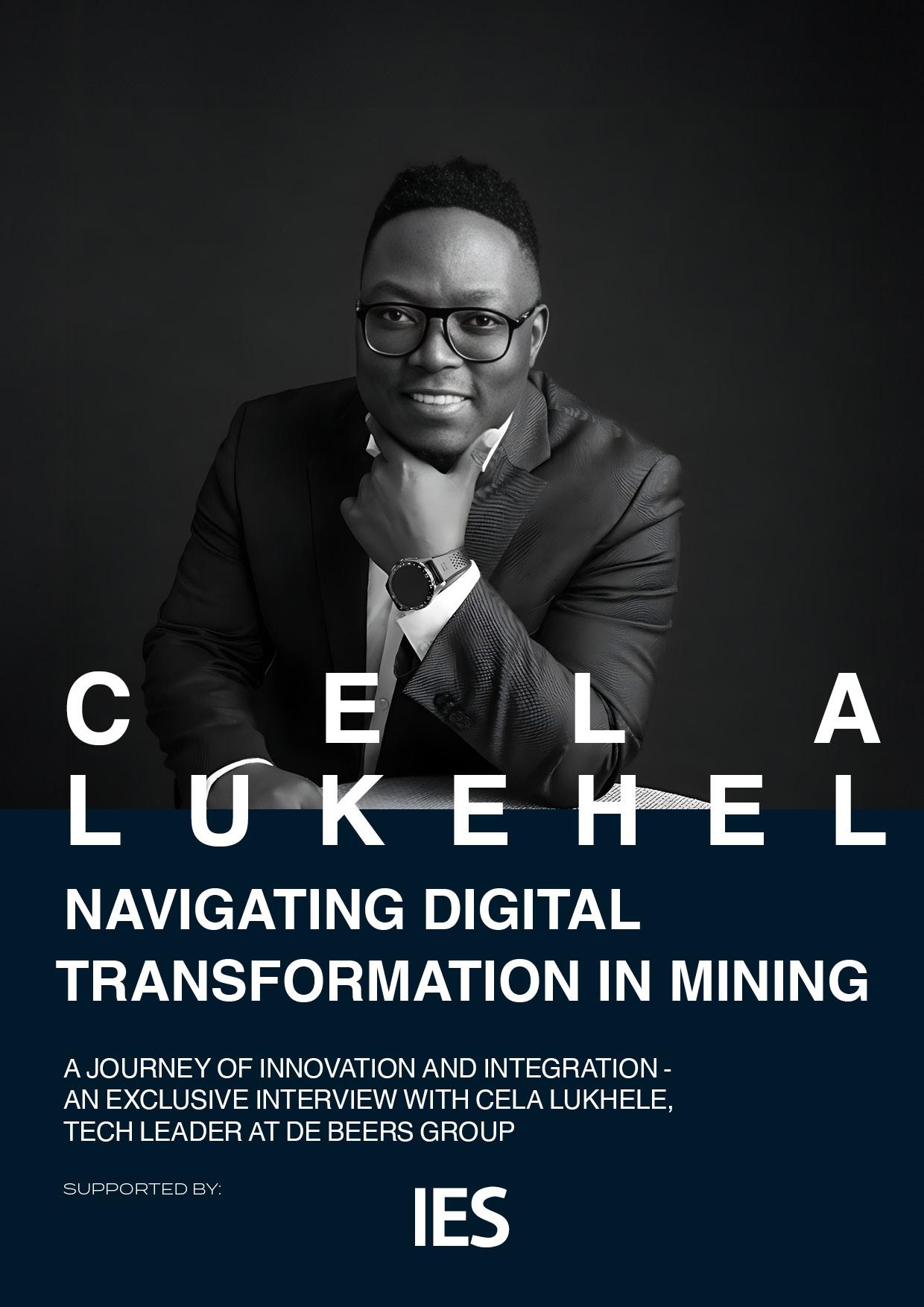

THE DIGITAL MEDIA PLATFORM FOR TECHNOLOGY LEADERS
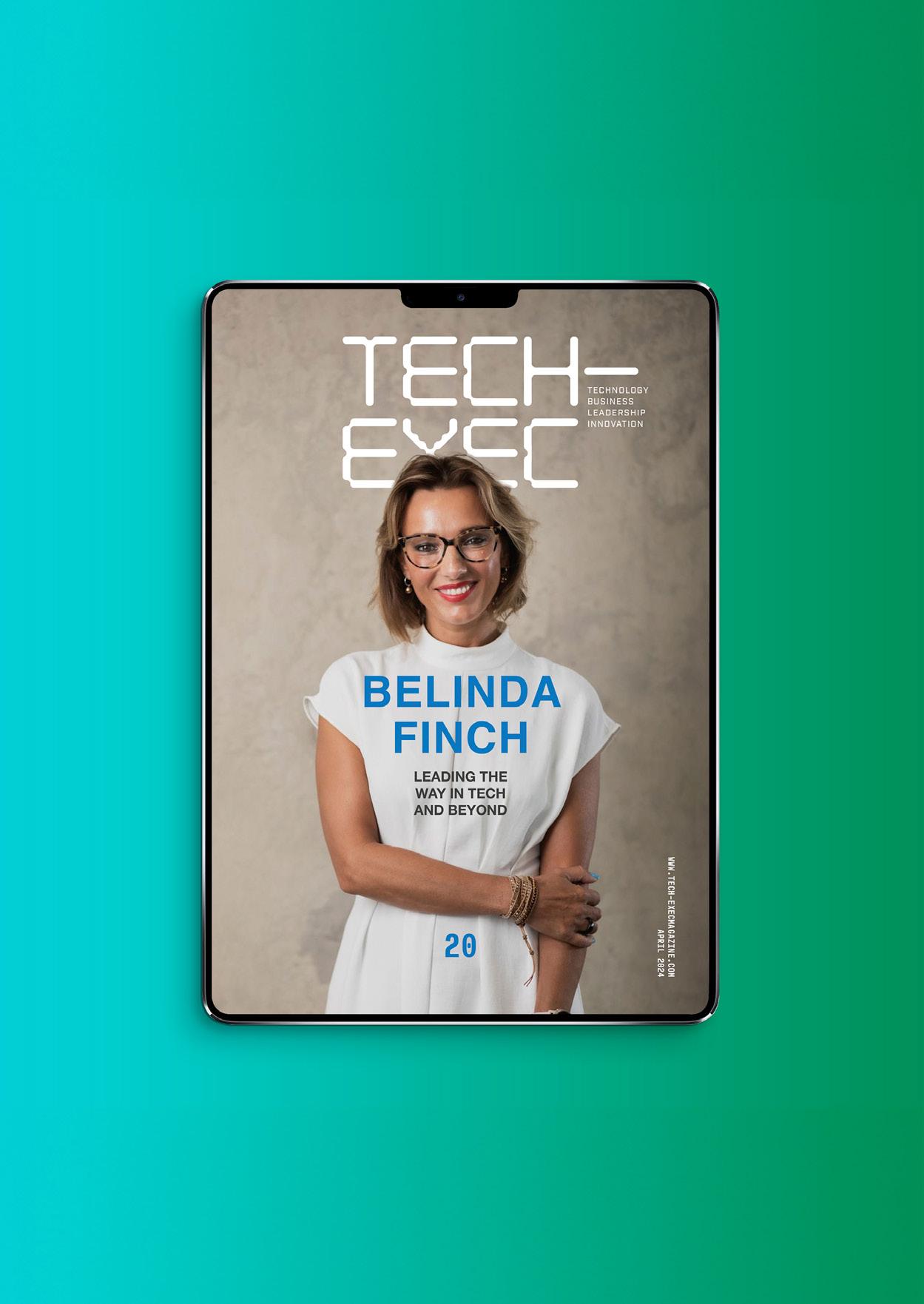
Tech-Exec is the destination for technology leaders, innovators and entrepreneurs—your essential source of C-level interviews, news, information, ideas and innovations.
READ THE LATEST ISSUE NOW

CAN YOU WALK US THROUGH YOUR JOURNEY IN THE TECHNOLOGY SECTOR, PARTICULARLY HIGHLIGHTING KEY MILESTONES DURING YOUR TIME AT ANGLO-AMERICAN AND DE BEERS GROUP?
Steve Jobs once said “You can’t connect the dots looking forward; you can only connect them looking backwards. So, you have to trust that the dots will somehow connect in your future”. This statement by Steve holds true for my career journey, when I transitioned from traditional engineering into a digital transformation career. I could have not in my wildest imagination thought that my digital transformation journey which started with Microsoft, that it will land me at De Beers years later. While at Microsoft, it dawned on me that I was more energized and impactful when engaging with heavy industry customers, thus at that time it became very clear that I needed to drive digital transformation within the heavy industry.
I returned back to the mining/heavy industry as a Digital Value Chain Lead for Exxaro Grootegeluk coal mine, then I moved on to
join Anglo American at Kolomela mine as Technology and Data Analytics Manager. I was responsible for implementing the mine technology and data analytics roadmap, emphasizing emerging technology and advanced analytics to support the mine’s operational goals of sustainable, safe, and efficient operations. With my team we were supporting the entire mine including support services/functions on their digital transformation journey. I realized that I was not well versed with geospatial data thus I was unable to effectively support the upstream of the mining value chain. To close this gap, I then enrolled for an honors degree in exploration geophysics with Wits. Also, joined De Beers Group Exploration as Senior Manager for Digital Data Transformation. This helps me with my Geophysics application while driving digital strategy thus effectively closing the GAP. My next career milestone will be to support the entire mining value chain on digital transformation once again (exploration to mine to port to distribution to customers) as I now have an in-depth understanding of the entire mining value chain business and operating model.

I am a firm believer that an in-depth understanding of the business model that you seek to digitally transform is critical for the organization to realize 10X growth from digital transformation apart from cost cutting and efficiencies. Hence, the breadth and width I have traversed to understand the mining, oil & gas, and energy industry value chain (business model).
HOW DID YOU APPROACH CHANGE MANAGEMENT WHEN IMPLEMENTING INTEGRATED OPERATING CENTRES (IOCS)?
I have learnt and used several change frameworks but the one that is engraved in my fiber i.e. I used it several times and always achieved good change in the McKinsey 7S framework. Structure – with the IOC it’s important to understand how the reporting lines are going to change, is decision making de/centralization in the IOC, and various sections/functions communication and activity coordination. Strategy – once the required change is understood then I crafted a clear change management strategy and plan. System – understand main systems that will be used in IOC, and how will these systems be managed. Shared value – understand the required culture shift required for IOCs’ success. Staff – profiles of the IOC staff and positions to be filled/removed. Style –
leadership style within the IOC, and Skills –key skills required, existing skills gaps, and on-going skills monitoring and assessment. The above framework provides a structured approach in consulting/engaging with key stakeholders. When I was assessing existing delta/GAP between AS-IS and desired/end STATE, I facilitated several design thinking workshops to gain insights from senior leadership in the organization, I delve down into the trenches (doing DILOs) with the operating, engineering, maintenance, and supporting services personnel having an intimate (heart-to-heart ) conversations about envisage changes and how should the future looks like, and ran trial shifts to test IOCs reporting lines and activities. I must point out that whilst consulting is good and necessary, decisiveness and leadership is paramount as you will never reach consensus with everyone. Trial and error with an organization through staff that is willing to participate/volunteer is key before you go on big recruitment to fill an organizational structure that will not work. I recall one key stakeholder calling an IOC a titanic movie in one of design thinking workshops. It became very clear to me that regardless of numerous engagements he was still not sold, and I had to make a call that will proceed with OR without his buy-in/support. A digital mindset acknowledges that you often start on a journey with incomplete information

INTELLIGENT CONTROL ROOM SOLUTIONS
Ergonomically designed environments, consoles and large integrated video walls enable quick response and monitoring.
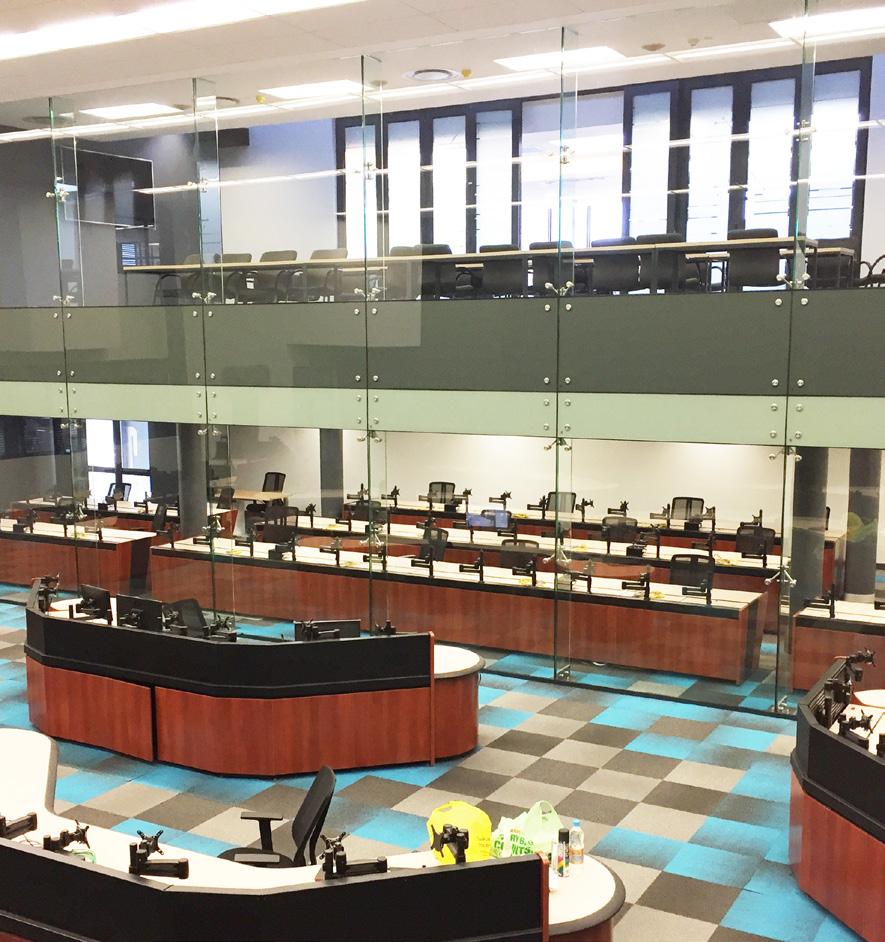
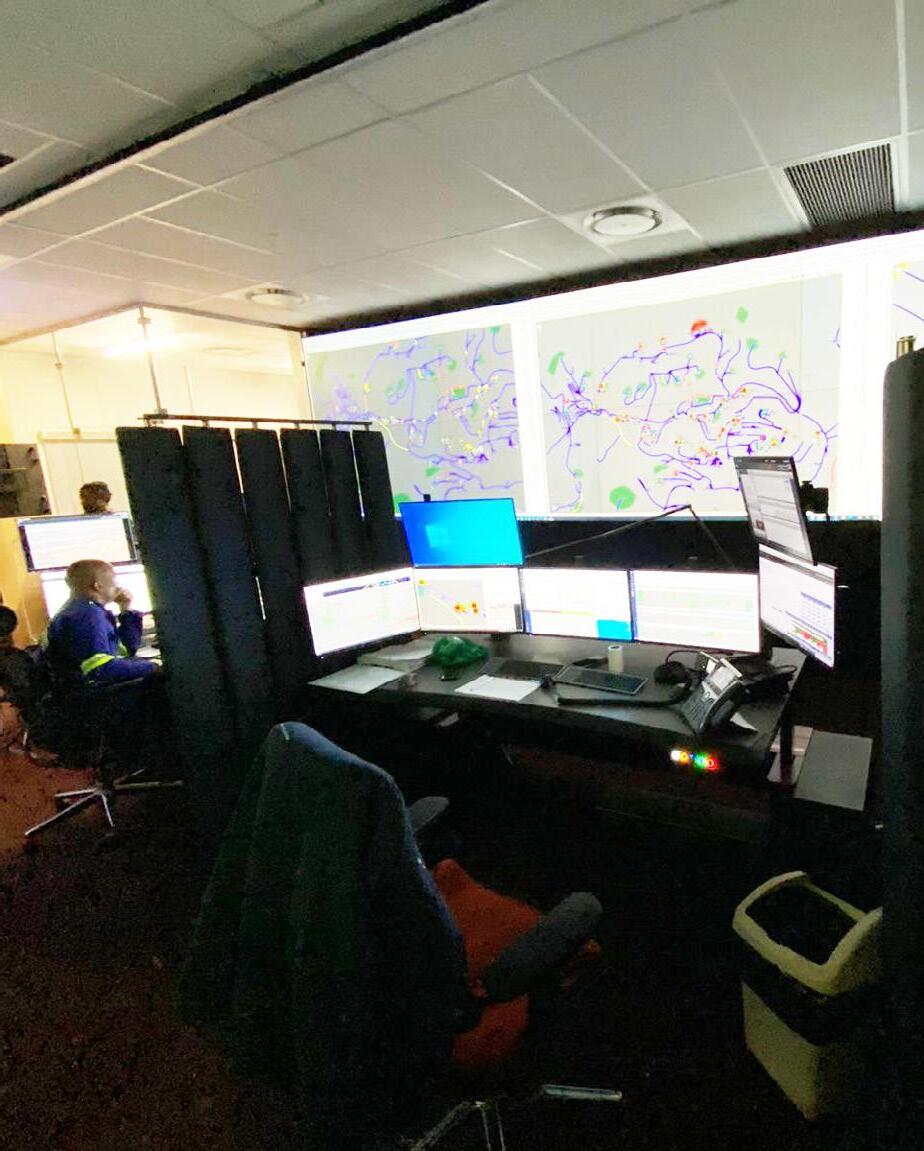





and you are only able to fully understand what you need by trying things and learning from the outcome of your experiments. However, be sure (hand to heart) to cover all the groundwork, then you will proceed with confidence regardless of who is for or against.
COULD YOU DELVE INTO THE SIGNIFICANCE AND IMPACT OF AI TECHNOLOGY, SUCH AS DRIVERLESS TRUCKS AND AUTONOMOUS DRILLING, ON THE MINING?
A digital mindset acknowledges that you often start on a journey with incomplete information and you are only able to fully understand what you need by trying things and learning from the outcome of your experiments. Thus, a concept of return on investment (ROI) versus return on learning (ROL). This holds true for most AI and automation projects I have implemented such as autonomous drilling. However, with AHS (Autonomous Hauling Solutions) agile approach proved to be very challenging because this requires upfront holistic investment (infrastructure requirements) in volumes to have a good NPV. AHS delivers safety, labour and productivity gains, however all the improvements that come from AHS are consumed by cost associated with AHS licensing, and EMV Kit subscriptions apart from AHS dedicated infrastructure. It should be noted however that my AHS experience with AHS goes as far as ROCx value engineering study because of the aforementioned reasons. I have implemented and optimized autonomous drilling, autonomous drilling can be implemented in an agile approach unlike AHS. The key performance indicators for autonomous versus manual drills includes improved maintenance availability, equipment utilization, tempo, diesel usage, and safety. Similarly, as mentioned above under change management, the 7S of change are key to the successful transitioning of manual to autonomous drills.
by automated and semi-automated road and plant inspections (visual and vibration) to identify and verify road defects and dustiness. Fitted to haul trucks, ARID was used for early identification, notification, and trending of road conditions deemed to present road usage safety hazards. The ARID units were mounted on the front of the haul truck where it had a view of the road, preferably close to the middle of the truck. Additionally, it was installed on a part of the truck structure that will give a good representation of the road vibration. Using automated processes such as Machine Learning and Artificial Intelligenceenabled systems and performance analytics and Dashboards; to monitor, record, score, and report on road conditions. Information was used in two ways, maintain roads (detects deterioration road conditions, generate notification and schedule work), keep drivers safe (used road conditions data to adjust in real time speed limits, monitor speed limits compliance, reroute traffic away from dangerous conditions).
AS A TECHNOLOGY LEADER,
HOW DO YOU ENSURE DATA ANALYTICS ENABLEMENT, DATA QUALITY, AND GOVERNANCE IN THE CONTEXT OF DEFINING THE DIGITAL STRATEGY FOR GROUP EXPLORATION?
Digital transformation focuses on five main areas i.e. customer experience, processes, business model, value chain, and culture. Now, one cannot focus on all five areas at the same time, but the area of focus is determined by industry and organisation digital maturity. Un/fortunately my focus has been mainly with the last four ever since I have rejoined mining, but while at Microsoft I have extensively dealt with customer experience. Quick wins and safe havens always lie with process efficiencies, whether in the core OR support business functions. My starting point has always been with process efficiencies and culture.
I have piloted and implemented numerous AI solutions. However, the one that I would like to discuss is ARID (Autonomous Road Inspection Device) that I implemented alongside a technology partner. ARID is primarily driven
In order to ensure enablement my focus always began with enabling digital citizens, by leveraging canvas platforms (click & drop) in transforming their business processes/ workflows thus gaining business buy-in and delivering quick business value. This means

cleaning and provisioning data at the level where digital citizens can meaningfully engage with the data. Also, I do process mining and identify processes that are candidates for RPA. I enabled culture by developing digital upskilling and data guidelines/policies. The data guidelines include governance of platforms & data sharing , role holders and required governance training. The business model i.e. how organizations create, deliver, and capture value through Digital Transformation i.e. transform/evolve/invent the business model for an organization to realize 10X growth apart from cost cutting and efficiencies. The latter is achieved once organisation achieve a certain level of digital maturity.
WHAT ROLE DOES CONNECTIVITY PLAY IN ENHANCING EXPLORATION AND MINING ACTIVITIES IN MINING AND REMOTE SITES, AND HOW HAVE YOU IMPLEMENTED THESE IN THE MINING SECTOR?
Most mining organisation are implementing (have implemented ) a connected worker initiative, and in all mining organisations I
have worked in I was/am involved with this initiative. The initiative is about integration and connecting of various equipment/devices i.e. OT, IT, and IM to support digitization strategy. Connectivity enables data-transfer for various production, health, and safety applications to allow in-time knowledge distribution, notifications, and decision-making support on multiple levels. I have been involved with implementation of Wi-Fi trailers, Mine-Mesh network, Mine-Fiber lines, brought in public towers inside the mine, radio communication & base station, and satellite (LEOs & GEOs) connectivity.
While working in the mining I drove realtime data analytics where I enabled operators and supervisors to communicate/visualize and discuss Key Performance Indicators throughout the shift not only during the start and end of shift. Without connectivity this was not going to be possible, and equipment condition monitoring & maintenance. While implementing and optimizing IOCs I installed cameras in the pits which streamed mining activities from the pit, and haul roads to the control rooms which required connectivity

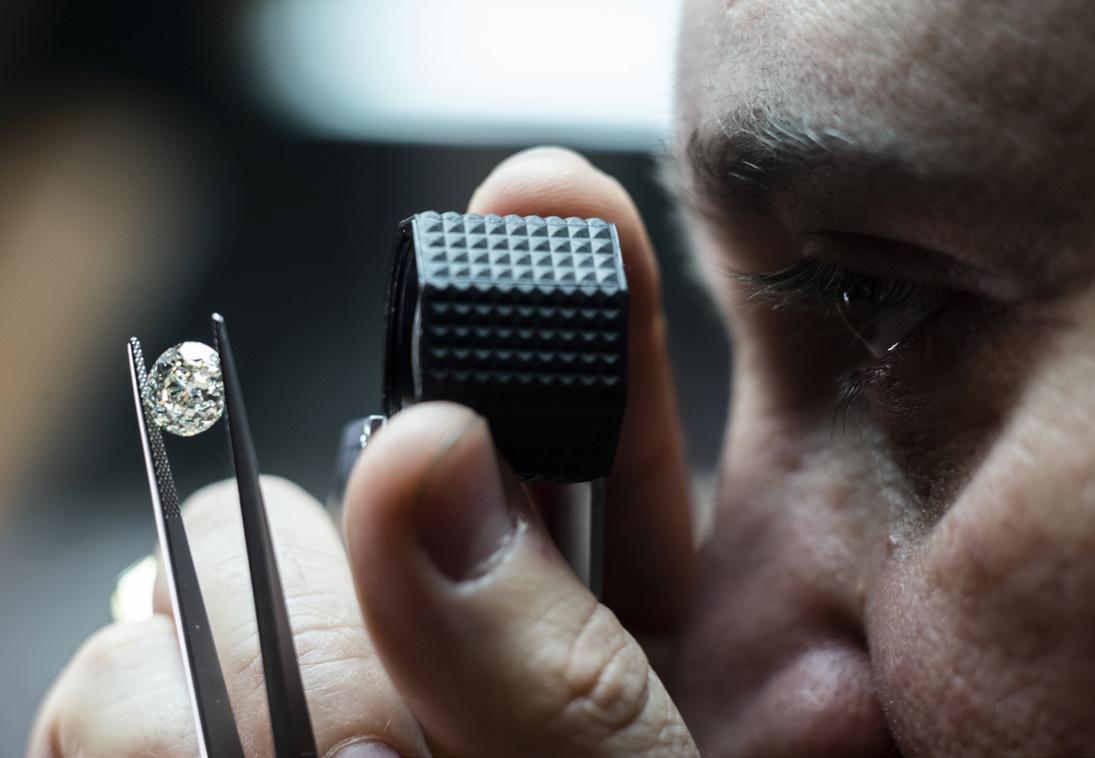

enablement. AHS and Autonomous drilling rely heavily on strong connectivity to prevent multifunctioning. Connectivity and communication strategy is generally driven by activities requiring enablement and solutions available in that geography. Mining OEMs generally cater for off-line and on-line mode functionality when developing mining technologies.
CAN YOU SHARE SOME INSIGHTS INTO YOUR CHALLENGES IN DRIVING DIGITAL TRANSFORMATION WITHIN MINING AND HOW YOU’VE OVERCOME THEM?
The main challenge is to get business involved (including doing the necessary upskilling) in actively driving digital transformation. This
is mainly because of the divide between business and digital. Amongst other reasons why Digital Transformation scales back OR spun out sometimes is that: Digital efforts are run by technology specialists as the rest of the organisation continues its work unchanged. Thus, DX grows disconnected from business needs and loses support over time. I have overcome this by having an in-depth understanding of the business model and operating model I seek to impact, understanding the main challenges that can be solved by digital transformation. Thus, by the time I engage business on the problem and the possible solution I have already covered 60% of groundwork. Prioritise bridging the divide i.e. business model divide for techies and digital divide for business personnel.

HOW DO YOU PRIORITIZE AND ALIGN DIGITAL INITIATIVES WITH THE OVERARCHING BUSINESS GOALS, OBJECTIVES AND EFFORTS?
In mineral exploration, targets need to be confirmed by means of drilling. Drilling is based on anomalies often detected in geophysical and/or geochemical studies. The main challenge is to know quickly with minimum drilling whether a target is mineable or not since drilling is costly, and mineral exploration has low success rate. Therefore, my duty is to look at the workflow (business model) and identify where digital data emerging technologies can be used to expedite exploration process and to improve success rate of exploration.
IN YOUR EXPERIENCE, WHAT ARE THE KEY CONSIDERATIONS WHEN PARTNERING WITH SENIOR STAKEHOLDERS ACROSS DIFFERENT DEPARTMENTS OR DIVISIONS TO IMPLEMENT DIGITAL STRATEGIES IN A LARGE ORGANIZATION LIKE DE BEERS?
The key is to first understand that you are there to help them achieve their KPIs through digital transformation, second clearly articulate the why, how, and by when, lastly be clear on the value i.e. ROI and/or ROL.
